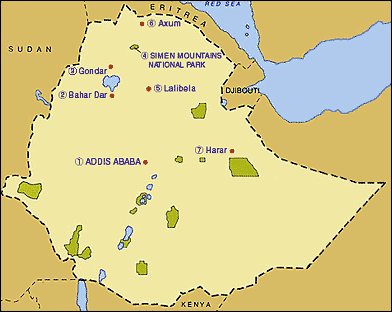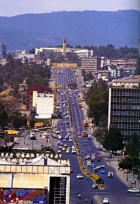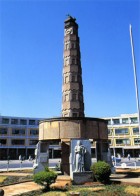Tourism | Popular Spot1 | Popular Spot2 | National Park | Tour Operators | Travel Advisories
Information on import & export or other Dealings in wildlife & wildlife production Ethiopia
CULTURAL ATTRACTIONS
Popular Spot1
- ADDIS ABABA
- BAHAR DAR
Blue Nile Falls (Tissisat)
LAKE TANA - GONDAR
- Simien Mountains National Park
- LALIBELA
- AXUM
- HARAR

ADDIS ABABA
With a population of more than four million people, Addis Ababa is not only the political capital but also the economic and social nerve-center of Ethiopia. Founded by Emperor Menelik 1887, this big, sprawling, hospitable city still bears the stamp of his exuberant personality. More than 21,000 hectares in area, Addis Ababa is situated in the foothills of the 3000 meters Entoto Mountains. Place to visit in Addis Ababa includes the Menelik Mausoleum, Trinity cathedral, St. George Cathedral, the National Museum, Ethnological Museum, the Jubilee Palace, Zoological National History Museum, Mercato – the Grand market, Africa Hall, Handicrafts Center, Ethiopian Postal Museum, Mount Entoto.
BAHAR DAR
The well-known lake shore town, situated at the southern most end of Lake Tana, first rose to importance in the 16th century and is now an important trading center and tourist town for lake visitors. Popular sites are tankwas, the famous papyrus canoes that are used by local woyto people. The town is also the main departure point for visits to the island of lake.
Blue Nile Falls (Tissisat)
Tissisat, or smoke of fire, is the local name for the Blue Nile Falls, the most spectacular waterfall in North Africa, and the most dramatic stretch of either the White or Blue Niles. 400 meters wide and dropping over a sheer cliff more than 45 meters deep, the falls generate a curtain of spray (often adorned by magnificent rainbows) that can be seen up to a kilometer away. The falls are about 35 km from Bahar Dar.
LAKE TANA
Lake Tana is the largest lake in Ethiopia (3,000km square) is the source of the famed Blue Nile which starts its long journey to Khartoun, and the Mediterranean. The 37 islands that are scattered about the surface of the lake shelter fascinating churches and monasteries, some of which have histories dating back to the 13th century. Kebran Gebriel is the principal monastery visited by male tourist from Bahar Dar, with its impressive, cathedral like building first built at the end of the 17th century. However, it should be noted that most of religious houses are open to women. Bird lovers will not miss Fasilidas Island. A sail or cruise on a Lake Tana is one of the most pleasant excursion for visitors to this region, particularly in the heat of summer.
GONDAR
Gondar has been called the Camelot of Africa. The capital of Ethiopia in the time of the 17th century. Emperor Fasilidas, the city is celebrated for its castle places built by the Emperor and many of his successors until the middle of the 19th century. The ‘imperial quarter’ is one of the most impressive vestiges of Ethiopia’s great past. Other treasures of Gondar include the 18th century palace of Ras Beit, the bath of Fasilidas the ruined palace of Kusquam, and the church of Debre Berhar Selassie with its unique murals.
Simien Mountains National Park
The Simien Mountains Massif is one of the major high lands of Africa, rising to the highest point in Ethiopia, Ras Dejen (4,620m), which is the fourth highest peak in the continent. Although in Africa, and not too far from the equator, snow and ice appear on the highest points, and night temperatures often fall below zero. The National park has three general botanic regions. The lower slopes have been cultivated and grazed, while the alpine regions (up to 3,600m) were forested, although much has now disappeared. The higher lands are mountain grass lands, with fescue grasses as well as heathers, splendid Red Hot pokers and Giant Lobelia. The park was created primarily to protect the Walia Ibex, a type of wild goat, and over 1000 are said to live in the park. Also in the park are families of the Galada Baboon, and the rare Simien Fox. Over 50 species of birds have reported in the Simien Mountains.
LALIBELA
Known as the Eight Wonder of the world, Lalibela is a revered spot to Ethiopians and foreigners alike. One is baffled by the immensity and beauty of twelve monolithic churches that were hewn out of rock over eight centuries ago.
The town is named for King Lalibela, who was born there in the early 12th century, and transformed into a natural wonder. At the moment of the future king’s birth, he was surrounded by a cloud of bees, and believing these to be the soldiers that wound one day serve her son, his mother gave him the name Lalibela, which means “the bees recognize his sovereignty”.
Legend has it that King Lalibela enlisted the help of angles to produce the miraculous rock-hewn churches. Standing in two groups, on either side of the Jordan River, the churches are still house of worship today. One of the churches is believed to contain the tomb of the king himself.
AXUM
Axum has a history that goes back more than 3000 year. It was the center of one of the first civilizations to adopt Christianity as a state religion. Axum’s greatest significance, however, is as the epicentre of the Queen of Sheba dynasty, upon which rests the rotion of the sacred kingship of the Semitic peoples of Ethiopia.
Axum is renowned for the world’s tallest monoliths, or Obelisks, carved from single pieces of rock. Some experts believe they were erected to work the passing of some ancient royal personages; others say that they had an astronomical function. The largest obelisks, measuring over 33 meters, fell long and now lies in pieces.
The oldest church in Africa, south of the Sahara, is the first St. Mary of Zion Church, originally build around the 4th century. Emperor Fasilidas replaced it with a newer church around 1635 which is still a place of active worship, notable for its crenellate, fortress-like walls.
HARAR
The city of Harar is an ancient (1520) and holy city. Always an important trading center, the city is famous for its ancient building, its great city walls, and as a center of learning and Muslim scholarship (the town has 99 mosques). The city is well known for its superb handicrafts that include woven textiles, basketware, silverware and handsomely bound books, and Harar has been a place of pilgrimage from all over the world for many years. Places to visit in Harar are, the city walls, Rimbaud House, The Hyena Men, and Babille Elephant Sanctuary.










